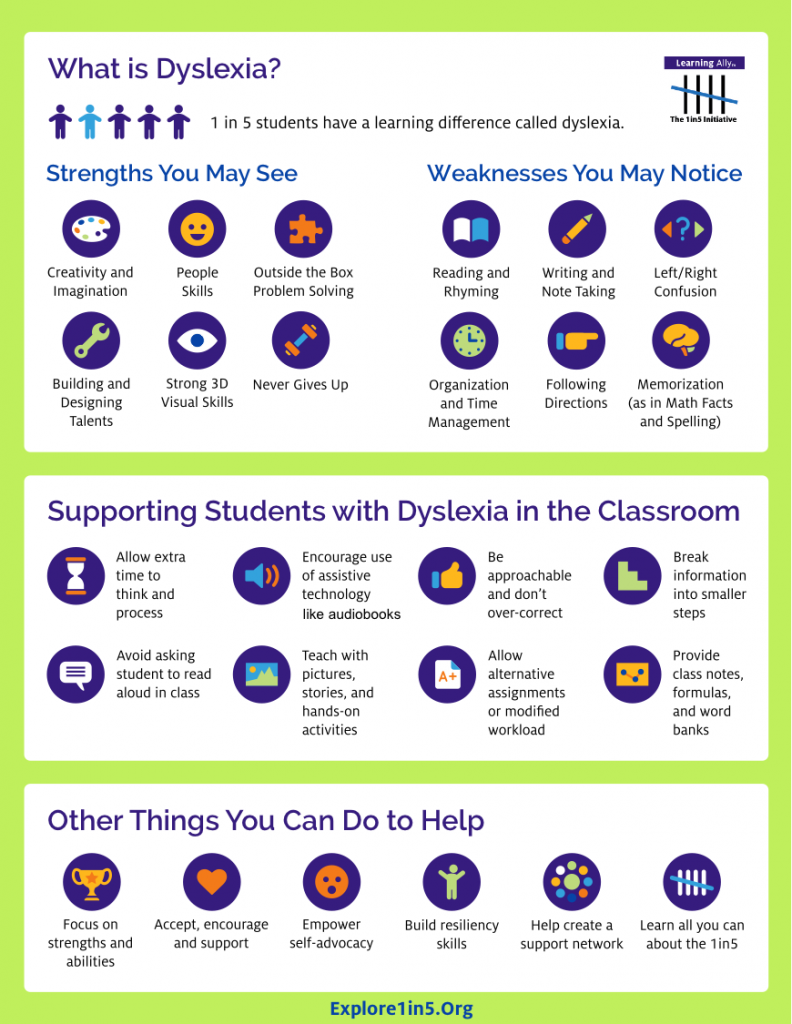Dyslexia

-
Dyslexia affects a child’s ability to learn to read and spell, but is not linked to general intelligence.
-
It includes difficulties in processing the sounds of words, making it hard to understand phonics; however, visual problems, such as short or long sightedness are unrelated.
-
It can sometimes be associated with other types of difficulties, such as maths or coordination skills.
-
Short-term memory and the speed of recalling names can be affected.
-
The severity of the condition can vary depending on other strengths or difficulties
experienced, and the kind of support offered, particularly within school and at home.
-
People with dyslexia often display strengths in reasoning skills and are drawn
towards visual/creative fields.
-
Dyslexia can be associated with other specific learning difficulties, such as dyspraxia,
attention deficit disorder and dyscalculia.
|
Support strategies Classroom environment
-
Ensure that all pupils can see your face clearly, and vice versa.
-
Consider seating pupils with dyslexia near to the front of the class, with a close friend
to act as a ‘buddy’.
-
Reduce distractions, e.g. shut doors to reduce noise and try to maintain a cool, but
not chilly room temperature.
-
Check that all pupils have enough personal space at their desk to aid their ability to
focus.
Giving instructions
-
At the beginning of the lesson, give an overview of what will be covered.
-
Break instructions down into clear, simple steps and give no more than three pieces
of information at a time.
-
Repeat instructions as necessary, in a friendly, patient manner.
|
| |
-
Check pupils understand by asking them to explain what has been said.
-
Use connectives to signpost instructions, e.g. ‘firstly’, ‘secondly’, ‘next’ and ‘finally’.
-
Display key words on the board or somewhere prominent, and ensure they are
visible for the whole lesson.
-
Use visual prompts to make explanations clear and handouts where necessary.
-
Develop clear routines for noting down homework information – give pupils plenty of
time to write down information and check that it has been recorded correctly.
Written material
-
Reduce the glare of black text on white paper by printing handouts on pastel- coloured paper or by using a pastel coloured overlay over white paper.
-
Provide ‘reading rulers’ for pupils who find that text ‘jumps around’ on the page.
-
Choose rounded, sans serif fonts, such as Arial, Verdana, Helvetica or Comic Sans.
-
Use a minimum font size of 12 or 14 and avoid justifying text, so there is a ragged
right margin. This can help pupils to follow the lines of text with their finger when
reading.
-
Double-line spacing and a line between paragraphs will make text easier to read.
-
Put headings and important information in bold text or highlight, to make them easier
to scan.
-
Present information simply, using bullet points, images or diagrams when possible.
-
‘Chunk’ numbers to make them easy to remember and/or copy, e.g. 864 126 321.
Spelling and handwriting
-
Teach vocabulary associated with words, such as vowels, consonants, syllables, suffixes, prefixes and homophones (words that sound the same, but are spelled differently), to aid learning.
-
Help pupils to learn the spelling of tricky words by using amusing mnemonics.
-
Encourage pupils to spell words aloud, allowing time for repetition or revision of
learning.
-
Use multi-sensory methods to reinforce letter writing, e.g. interactive whiteboards,
iPads, spelling/writing apps.
-
Teach primary pupils how to write using cursive script if possible, as it can aid the
‘physical memory’ of each letter. The continuous flow of writing also helps to improve
handwriting speed and pupils are less likely to reverse letters such as ‘b’ and ‘d’.
-
Consider the use of rubber pen grips or typing of written work for pupils with severe
writing difficulties.
Confidence building
-
Mark work on content where there is a large amount of incorrect information.
-
Rather than crossing work, just tick what is correct, then follow up misconceptions
with pupil.
-
Do not draw attention to every spelling error – instead, ‘pattern mark’ work to focus
on specific types of spelling errors.
-
Do not minimise difficulties – instead, help pupils to recognise, understand and tackle
problems.
|
|
|
| |
• Set achievable targets, with clear steps to help pupils meet them.
• Encourage independent learning, nurture strengths and praise effort rather than ability. Where at all possible, make praise specific.
Study strategies
-
Encourage the use of highlighters to select key information from key texts.
-
Use writing frames to help pupils organise their ideas and structure written work.
-
Create a short checklist of error patterns for pupils to look out for, such as
spelling errors, commas, full-stops, capital letters and apostrophes.
-
Give pupils time to organise equipment at the beginning of the lesson, and to
clear away at the end.
-
Allow pupils enough ‘thinking time’ to process any information or instructions.
-
Never demand a complete re-write of work – this would be extremely
demoralising for a pupil with dyslexia.
Files to Download
